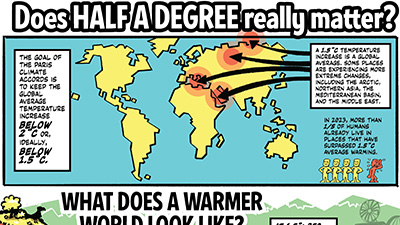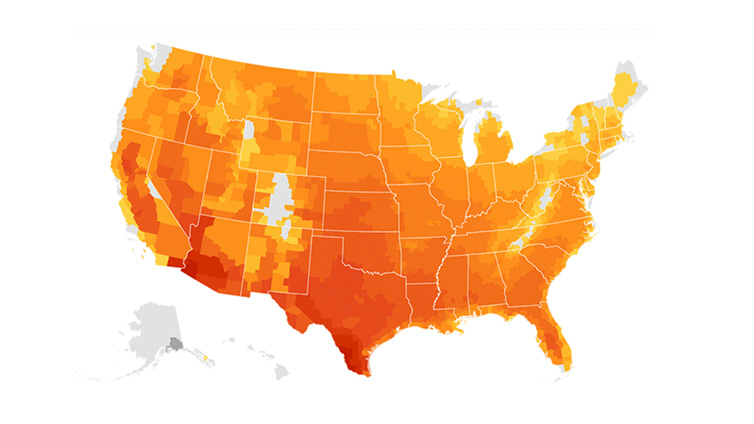Direct Impacts of Climate Change
Teacher Resources
Driving Question: How is climate change affecting natural systems?
How are rising global temperatures directly tied to changes in Earth’s natural systems? This lesson explores why every fraction of a degree matters in shaping climate outcomes.
Learning Objectives:
- Identify and describe direct impacts of climate change.
- Analyze a direct impact to understand it’s effects and potential future consequences.
- Explain why small amounts of warming are significant when it comes to climate impacts.
Vocab Terms:
- biomes
- climate model
- direct impacts
- sea-level rise
- temperature anomaly
Opener: Direct Impacts of Climate Change
To teach this lesson step, refer to page 2 of Lesson 2.2 Teaching Guide.
New to teaching about climate change? Join our online teacher community.
What are some direct impacts of climate change, and how do changes in one system effect other areas?
Measuring Impacts
Bringing climate change into your lesson on biospheres and ecosystems? Check out this lesson in OER Project: Big History for more resources.
Explore the Climate Project Infographics Guide for some tips for using infographics in the classroom.
How much of an impact can half a degree really have? Study the infographic to see how a seemingly small temperature increase can make a big difference, and then complete the writing activity to make a case for why each fraction of a degree matters.
-
Guiding Questions
-
Before you read
Preview the questions below, and then skim the full infographic, paying attention to things like prominent colors, numbers, charts, and types of text. How do you know where to start and in which direction to read? How do you know which numbers are most important? What concept is the focus of the graphic?
While you read
Look for answers to these questions:
- Will everyone experience the effects of warming temperatures equally? Why or why not?
- How will half a degree difference affect conditions on land?
- How will half a degree difference affect our oceans?
After you read
Respond to this question: Choose one of the five direct impacts covered in the graphic. Will this change impact your life or your community? How?
Climate Impacts Data
To teach this lesson step, refer to page 4 of Lesson 2.2 Teaching Guide.
Our Data Literacy Guide provides a summary of strategies to help students read the data, read between the data, and read beyond the data – check it out!
Read the article to explore some of the numbers behind the impacts of rising temperatures on one natural system. Then, do your own research and investigate a direct impact of your choice.
-
Guiding Questions
-
Before you read
Preview the questions below, and then skim the article. Be sure to look at the section headings and any images.
While you read
Look for answers to these questions:
- According to Chart 1, how have global sea levels changed over the last 1,000 years?
- What correlation is suggested by Chart 2?
- According to Chart 3, how has the rate of global sea-level rise changed in the last 150 years? Where does this data come from?
- According to Chart 4, what will determine how much sea levels rise over the next century?
- What do the two maps tell you about the importance of this direct impact for human communities around the world?
After you read
Respond to this question: Sea-level rise is connected to several other direct impacts. What other direct impacts do you think will be made worse as sea levels rise? How so?
Climate Maps
If your students are new to working with maps, this Big History course introductory activity is a great place to start.
For more detailed directions for reading charts check out A Guide to Reading Charts.
Practice your data-literacy skills as you explore how our actions can influence the severity of climate impacts over time.
Closer: Direct Impacts of Climate Change
To teach this lesson step, refer to page 8 of Lesson 2.2 Teaching Guide.
Think about the ways many different systems are interconnected and can be impacted by climate change, and what that means for you and your community.







